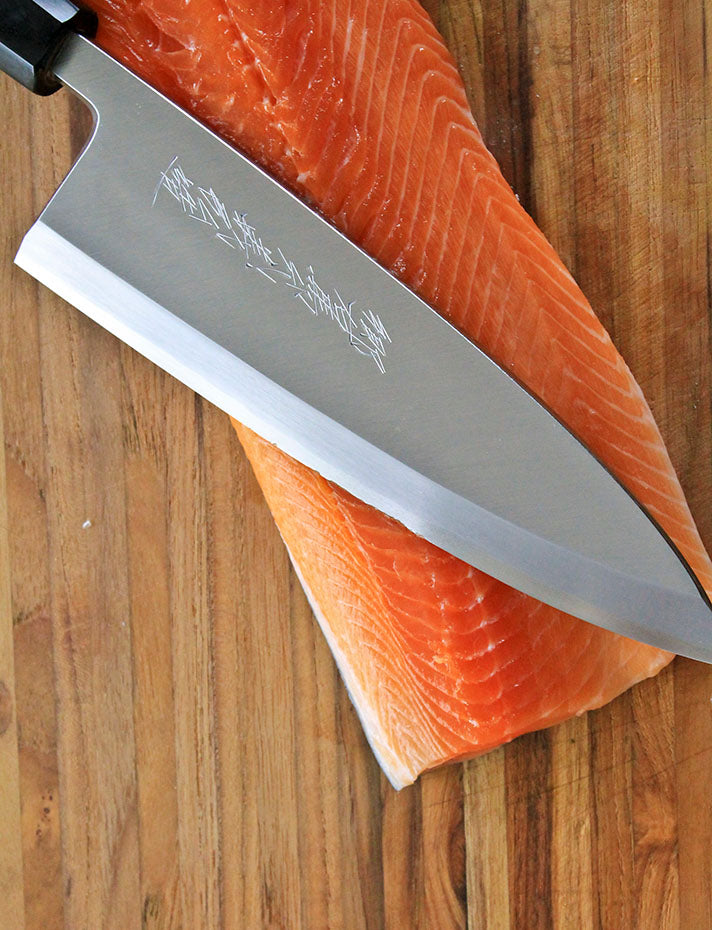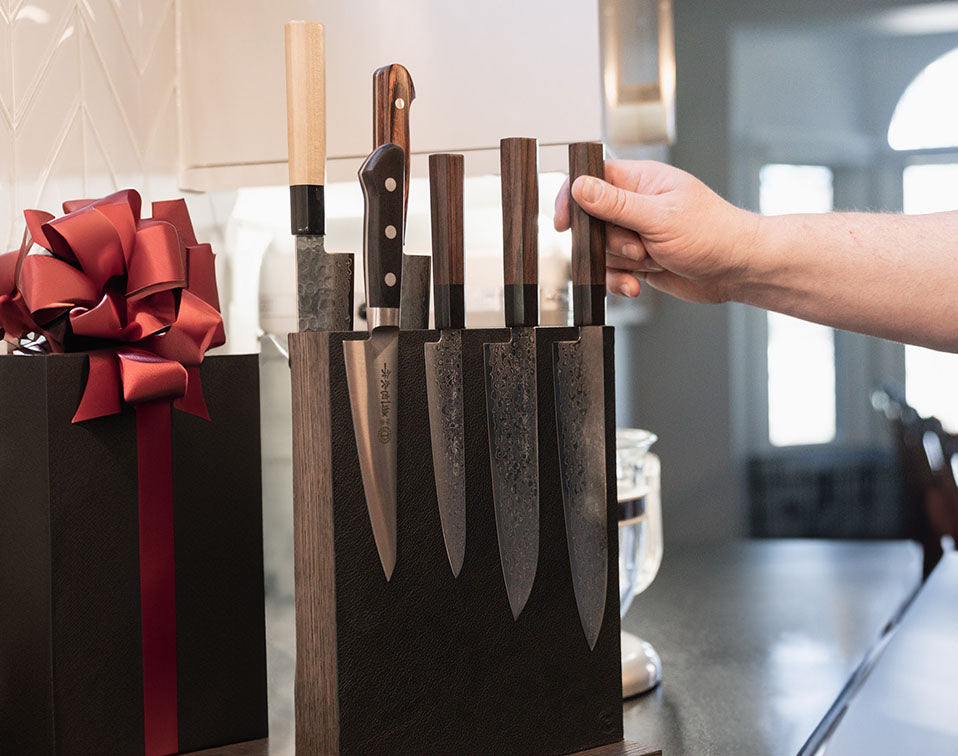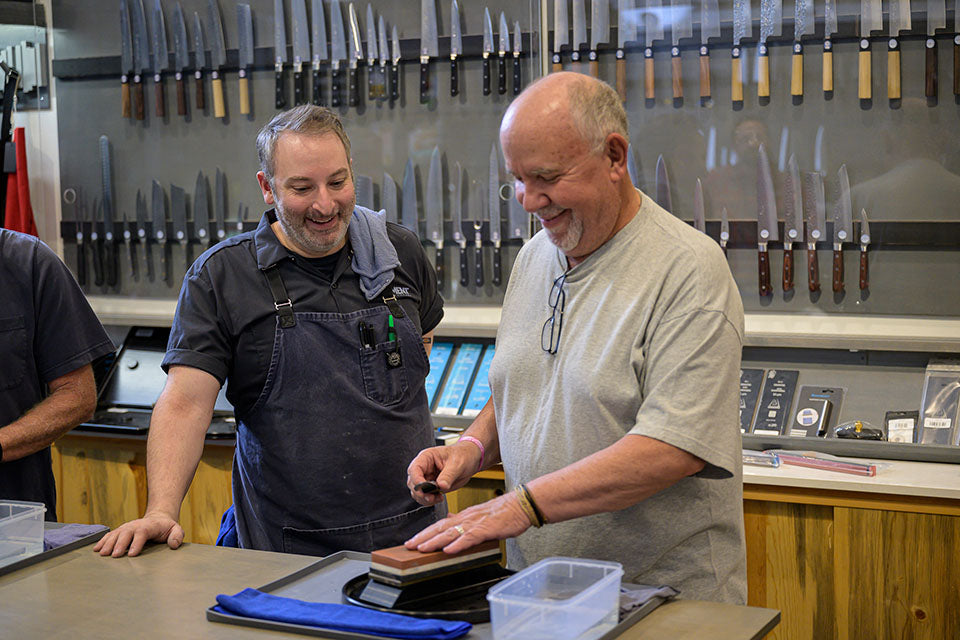Common Questions About Kitchen Knives

Kitchen Knife FAQ
If you have questions about kitchen knives, you're not alone. Knowing which knives to buy, how to care for them, and when to replace them can be a bit confusing for many people. The good news is that with a little knowledge, proper maintenance and use, you can ensure your kitchen knives stay in great shape for a very long time. Here are some common questions we are asked regularly. We are always here if you have more questions. Drop us a line anytime! Contact Us
Common Questions About Kitchen Knives
Knife Buying FAQ
If you could only have one knife, what should it be?
A Chef Knife or Gyuto is the answer, hands down. It is the most versatile shape. It can handle almost any task, from fish, meat and veggies.
What factors should I consider when buying a knife?
When buying a knife, consider factors such as the blade material, handle comfort, blade type (e.g., Chef Knife, Santoku, Paring Knife), and your intended use. Quality, balance, and ease of maintenance are also important. Please check out our Knife Buyer's Guide for more info.
How do I choose the right knife for my needs?
Identify your primary use (e.g., chopping, slicing, dicing) and choose a knife that suits those tasks. For general use, a chef knife is versatile. For specific tasks, consider specialized knives like boning or serrated knives. Check out our Knife Buyer's Guide for more info!
Should I buy a knife set or individual knives?
It depends on your needs. A knife set can be a cost-effective way to get multiple essential knives, while individual knives allow for more customization based on your specific preferences and uses.
How do I know if a knife is high-quality?
High-quality knives are made from durable materials such as carbon steel or stainless steel with a good feel for the fit & finish. Look for a well-balanced knife with a comfortable handle and a precise edge. Brands with a strong reputation are also a good indicator. Understand that there is a distinct difference between an affordable knife and a cheap knife. Cheap knives are made with cheap materials, cost cutting in the manufacturing with a poor heat treatment. An affordable knife will last a lifetime if treated properly. The takeaway is that you don’t have to spend a lot to get a great knife.
Are there specific knives for different types of cuisine?
Yes, different cuisines may require specific knives. For example, a Santoku knife is popular in Japanese cuisine, while a boning knife is essential for butchering. Research the types of knives that best suit the cuisine you frequently cook. Note that we offer a ‘Know your knife’ category in our learn section.
What should I look for in a knife handle?
Choose a handle that feels comfortable and provides a secure grip. Handles can be made from wood, plastic, or composite materials. Ensure the handle has a well-shaped design, fitting comfortably in your hand. Learn more about knife handles HERE.
How do I choose between a single-bevel and double-bevel knife?
Single-bevel knives are ideal for precision tasks and are commonly used in Japanese cuisine in professional commercial settings. Double-bevel knives are more versatile and easier to maintain, suitable for a variety of cutting tasks, and more commonly used by home cooks and professionals. Choose based on your specific needs and preferences.
How long will a knife stay sharp?
In a home setting, if you cook a lot, a knife will stay sharp for 3 to 6 months. There are variables to consider. It's recommended not to cut on plates, glass, marble, or other very hard surfaces. Try not to scrape the blade to move food products. In a professional kitchen, it is recommended that knives be sharpened every 1 to 3 days. At this frequency, it's more maintenance than sharpening.
Are there right and left-handed knives?
Single-bevel knives are designed for specific hands. Double-bevel knives are ambidextrous in terms of the blade, but some manufacturers use traditional Marushinogi handles (oval with a single ridge ‘teardrop’), making them hand-specific.
How should I hold a knife?
For most knives, it's always a good idea to use a pinch grip. This means that you will choke up on the handle somewhat and pinch the blade between your thumb and forefinger. This allows for a light grip offering good control and preventing your hand and arm from fatigue. Always make sure to use the claw method with your other hand that is controlling the food.
How do I care for my new knife?
Care for your knife by hand washing it with mild soap and water, drying it immediately, and storing it properly. Regularly hone the blade to maintain sharpness and avoid using it on hard surfaces.
Which is better, carbon or stainless steel?
It comes down to what is better for the user. There are pros and cons for both. Carbon steels take a keener edge, sharpen easier (if maintained on a stone regularly), and have impeccable edge retention. But, the blade surface is very reactive to anything with an acidic pH. It takes a higher level of care and maintenance. Stainless steel knives don't require as much attention because they are resistant to rust and tarnishing. They do require sharpening more frequently.
Which are better, Japanese or German knives?
Despite their differences in design and functionality, both Japanese and German knives are renowned for their craftsmanship and quality, backed by centuries of tradition. This means that ultimately, it is what is best for the user. Japanese knives are thinner, lighter, and harder. This means better edge retention but more fragile. German knives tend to be thicker, weightier, and have softer steels. This means more versatility, and the steel is more forgiving with very hard food products. Learn more about the differences between German and Japanese knives HERE.
What is the difference between a straight-edge and a serrated knife?
Straight-edge knives are versatile and ideal for most cutting tasks. Serrated knives, with their jagged edges, are designed for cutting through tough or fibrous materials like bread and tomatoes.
What is a "Granton edge" and how does it benefit cutting?
Sometimes called Kullenschliff, a Granton edge features hollowed-out indentations along the blade that reduce friction and prevent food from sticking. It is particularly useful for slicing through sticky or starchy foods.
How do different handle materials affect knife performance?
Handle materials like wood, plastic, and composite each offer different benefits. Wood handles are comfortable but require more maintenance, plastic is durable and easy to clean, and composites offer a balance of durability and aesthetics.
How do I choose between a forged and a stamped knife?
Forged knives are made from a single piece of steel and are generally more durable and balanced. Stamped knives are cut from a sheet of steel, making them lighter and often more affordable. Learn more about Stamped vs Forged vs Stock Removal HERE.
How do I choose a knife based on its weight and balance?
Hold the knife to check its weight and balance. A well-balanced knife should feel comfortable and balanced in your hand, with no heavy or light spots that might affect cutting performance.
Is a heavier knife better?
Weight is not an indication of the quality of a knife. A heavy kitchen knife will be great for cutting large, tough vegetables, so you may want to have one weighty blade in your set. It is important that you handle a large selection of knives when you are considering your purchase. Choose the one that has the right amount of weight behind it to suit the way that you cook. Check out our Knife Buyer's Guide for a more guided process.
What is the significance of blade thickness in a knife?
Blade thickness affects the knife’s performance. Thicker blades are sturdier and better for heavy-duty tasks, while thinner blades offer more precision and are ideal for delicate slicing.
How long will a knife last?
If treated correctly, any well-crafted knife will last a lifetime and can be handed down as an heirloom. What this means is never put knives in the dish washing machine. Simply use the knife, wash the knife with warm, soapy water and then dry it before putting it away. Also, never use a knife like a screwdriver or a hammer. Don't mistreat the knife and use it for things that it's not intended for, like cracking open coconuts or hacking at can lids.
Are ceramic knives any good?
Ceramic knives are 50% harder than steel and have half the weight. They stay sharp for a long time and are corrosion free. Hard translates to brittle, so be careful not to drop a ceramic knife.
Common Questions About Kitchen Knives
Knife Care & Maintenance FAQ
If I sharpen my own knives, what do I need?
There are different tools and implements to sharpen knives. A good pass-through sharpener can keep a nice sharpness regularly. It's important when using these to not put your body weight into them and only use about a pound of downward pressure. Sharpening stones yield fantastic results but must be used properly. It takes a lot of patience, persistence, and practice to learn how to sharpen by hand on sharpening stones.
Will a dishwasher harm my knives?
100% absolutely yes! The conditions of a dishwashing machine are too adverse. High heat, high-pressure jetting, and corrosive concentrated detergents will wreak havoc on handles, connection points and possibly cause rusting, even on stainless steel. It's always best to wash your knives with warm soapy water, rinse them, then dry them before putting them away.
Can I use my knife to cut through bones?
While some knives are designed for cutting through bones, such as meat cleavers, many knives are not. Using a knife not designed for bones can damage the blade. Use a dedicated bone-cutting knife for this purpose.
Can I use my knife on all types of surfaces?
Avoid using your knife on hard surfaces like glass, granite, or metal. Instead, use softer cutting boards made from wood or softer plastics to protect the blade and maintain its sharpness.
Can I use a knife with a damaged blade?
Using a knife with a damaged blade is not recommended, as it can be dangerous and ineffective. It’s best to have the knife repaired or sharpened by a professional. Our retail location in Denver offers in-store knife repairs. Check out our repair rates.
Can chipped blades and broken tips be fixed?
Yes, chipped and broken tipped knives can be fixed. Typically the blades will be ground, reprofiled, then sharpened.
Where can I get my knife repaired or sharpened?
If you're in the Denver area, you can have your knife sharpened or repaired at Element Knife Company. We offer expert hand sharpening and a range of repair services to restore your knife’s performance. Check out our Services page for more info.
Is a sharp knife safer than a dull one?
Absolutely! A sharp knife will "bite" into food products, cutting through instead of smashing them. When a knife is dull, the user tends to push harder. A dull knife might slip off the food and has the potential to cut your finger. A cut from a dull knife takes longer to heal.
What is the difference between sharpening and honing?
Sharpening is removing material from the blade, creating an edge or bevel. This creates burrs, and sharpness is all about the burrs. What's a burr, you ask? Put simply, it is "a rough edge or ridge left on an object (especially of metal) by the action of a tool or machine." They are created at the apex of a knife's edge when sharpened, then refined and ultimately lined up. The burrs then act as tiny little serrations and help a knife cut through food products easily. They are so tiny that you can't see them with the naked eye. Once the knife is used after sharpening, the blade's cutting edge makes contact with food products and cutting surfaces. This affects the burrs by bending them out of alignment. This is where honing comes into play. Honing realigns the burrs, which makes the knife sharp again.
How should I care for my knives between sharpening sessions?
Hone your knife regularly and clean it with mild soap and water. Always hand dry it immediately to prevent rust. Avoid cutting through hard materials like bones or frozen food to preserve the edge.
Can you sharpen knives that are extremely dull?
Yes, for extremely dull knives, we may use specialized machinery to start the process before finishing them by hand on sharpening stones to achieve the sharpest edge.
What is the best way to test the sharpness of my knife?
To test sharpness, use the “paper test” by slicing through a piece of paper. A sharp knife will cut cleanly without tearing. You can also test the edge by carefully slicing through soft vegetables or fruits.
What is the best way to break in a new knife?
Muscle memory is a real thing. It takes a little getting used to, so go slowly and safely for the first few cooking sessions. Your new Knife from Element Knife Company is SHARP! Going slowly in the very beginning of use will help you become accustomed to its feel and weight. Regular use and proper maintenance will help it perform optimally.
How do I properly store my knives?
To keep your knives in good condition, store them in a knife block, on a magnetic strip, or in a blade guard. Avoid storing them loosely in a drawer where they can be damaged or cause injuries.
What is the best way to clean my knives?
Clean your knives by hand with mild soap and warm water. Avoid soaking them or using harsh detergents. Dry them immediately with a clean towel to prevent rust and water spots.
How often should I sharpen my knife?
The frequency of sharpening depends on usage. Generally, knives should be sharpened every 3-6 months. Regular honing can help maintain the edge between sharpenings.
How often should I hone my knives?
Honing should be done regularly, about every 1-2 weeks, to maintain the blade’s edge between sharpening sessions. Use a honing steel or a ceramic rod to realign the edge.
Can I use my knives for tasks other than cutting?
It’s best to use your knives for their intended purpose. Avoid using them for tasks like prying or cutting through bones, as this can damage the blade and edge.
What should I do if my knife develops rust or stains?
If your knife develops rust or stains, gently clean the affected area with a mixture of baking soda and water or a rust eraser. For more severe cases, professional cleaning or restoration may be necessary.
How can I prevent my knife handle from loosening?
Ensure that the handle is kept dry and clean. Avoid exposing it to excessive moisture or extreme temperatures. Regularly check the handle for any signs of loosening and have it repaired promptly if needed.
How should I handle and transport my knives to avoid damage?
When handling or transporting knives, always use a blade guard or wrap them securely in a cloth. If traveling, consider using a knife roll or case to prevent damage and ensure safety.
What should I do if my knife is chipped or damaged beyond sharpening?
If your knife has significant damage beyond what sharpening can fix, consider a repair service or consultation with a professional to determine the best course of action for restoration.
What maintenance is required for a knife with a wooden handle?
Wooden handles require regular cleaning and conditioning to prevent drying and cracking. Apply a food-safe mineral oil periodically to maintain the handle’s condition and prevent moisture damage.
Are there any specific care tips for high-carbon steel knives?
Carbon steel knives require extra care to prevent rust. Since the blade is reactive to anything with an acidic pH, Always wipe the blade thoroughly after cutting citrus and tomatoes for example. Make sure to put away the blade bone dry and store it in a dry place. Apply a light coat of Tsubaki oil to protect the blade from humidity. If you can care for a cast iron skillet, you can care for a carbon steel Knife!
Learn Center
- Choosing a selection results in a full page refresh.
!













































